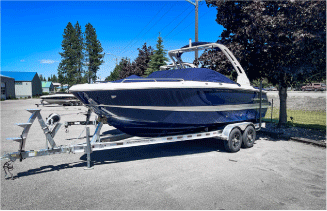Surge Brakes

When your Surge Brakes don’t Allow you to Reverse your boat Trailer
Few things are more frustrating before or after a day of boating than a boat trailer that won’t allow you to reverse due to malfunctioning surge brakes. In this post, I will briefly describe how surge brakes function. More importantly, I’ll describe a few items to check and how to manually disengage the trailer brakes, to allow you to reverse your trailer.
Surge brakes, also referred to as hydraulic brakes are a trailer braking system that uses the momentum of the trailer pushing on the tow vehicle to automatically engage the trailer brakes when slowing down. Behind the coupler (the equipment that attaches the trailer to the tow vehicle), within the frame of the trailer is a master cylinder. As the tow vehicle slows down, the weight of the trailer pushing against the tow vehicle compresses the cylinder and engages the trailer brakes.
The advantage of hydraulic brakes is they eliminate the need for electricity and a brake controller wired into the tow vehicle. However, putting the tow vehicle in reverse and pushing against the trailer will engage the brakes, locking up the trailer wheels. To eliminate this, trailers equipped with surge brakes have a solenoid that disengages the brakes when reverse is selected in the tow vehicle. The signal is fed either through the center pin on a 7-way plug or the 5th (outer) pin on a flat style trailer plug.
Things to check
I found that nearly 100% of the time, in my twelve years and over 400,000 miles of hauling boats, a boat trailer wouldn’t reverse because of 2 or 3 things I had to check. The first thing is to check the connection of the trailer plug and give it a shake. If the plug is inserted correctly, unplug the trailer, and ensure the contacts are not bent and are clean/free of corrosion. Also, check for broken or frayed wires on the trailer.
The second thing to check is the trailer reverse light fuse on the tow vehicle. In late-model GMC Sierras, which we use here at Tobler Marina, it is a 10-amp fuse (#16), in the fuse box located under the hood next to the battery. Each vehicle manufacturer uses a different size fuse in a different location, so familiarize yourself with where it is and carry extra fuses in your glove box.
While these are certainly the most common and easily remedied faults that occur, there is always the possibility that the problem lies deeper in the wiring of the truck or trailer. The best solution at that point would be to contact your vehicle’s service department and have the trailer wiring tested and checked. However, there is a temporary solution to get your boat backed down the ramp or parked in your driveway at the end of the day!
Manual lockout
On most newer trailers, there is cut out in the trailer frame near the coupler. The hole is an oval shape, approximately 1” long and ½” tall. Placing a ½” nut or socket, or a trailer reverse lockout key into the hole will manually prevent the coupler from compressing the master cylinder. In turn, disengaging the brakes and allowing the vehicle to reverse. Manually locking out the surge brakes is effective when in a hurry, or to prevent blocking a boat ramp or parking lot. However, make sure you remove the lockout before traveling on public roads to ensure your trailer brakes will work effectively. Some older boat trailers also have manual lockouts on the trailer. This can be a pin that needs to be moved into a certain position, a dial, or a switch mounted on the top of the trailer tongue. Trailer lockouts are available here at Tobler Marina located near beautiful Coeur d’Alene, Idaho.
If you have any questions regarding surge brakes, please email me at: Kadams@toblermarina.com and I’d be happy to answer them for you.







